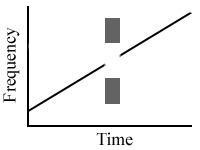 | ||
The illusory continuity of tones is the auditory illusion caused when a tone is interrupted for a short time (approximately 50ms or less), during which a narrow band of noise is played. The noise does, however, have to be of a sufficiently high level to effectively mask the gap. Whether the tone is of constant, rising or decreasing pitch, the ear perceives the tone as continuous if the 50ms (or less) discontinuity is masked by noise. Because the human ear is very sensitive to sudden changes, however, it is necessary for the success of the illusion that the amplitude of the tone in the region of the discontinuity not decrease or increase too abruptly.
Most probably, this happens because of the way that the human ear adapted to filter out the background noise from signals (visual, acoustic, tactile etc.) in order to show one signal disturbed by noise as one event, not several. (A longer change in the signal could mean a different event.)
Relation to other auditory illusions
Illusory continuity is antagonistic with illusory discontinuity. While illusory continuity restores perceptual continuity of obscured sounds, illusory discontinuity disrupts the perception even if the sound is indeed continuous. Listeners strongly susceptible to illusory discontinuity do not perceive illusory auditory continuity.
